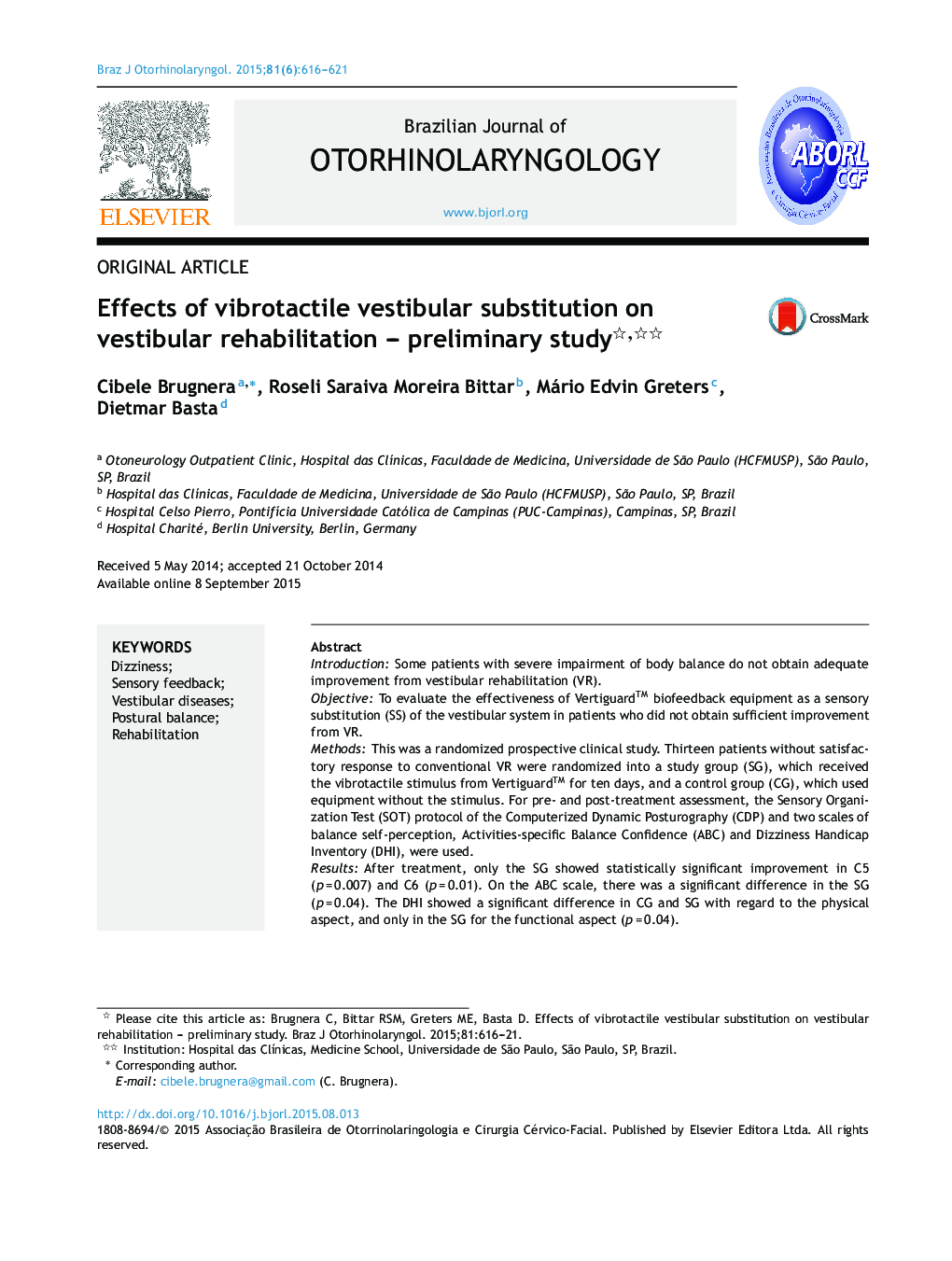| کد مقاله | کد نشریه | سال انتشار | مقاله انگلیسی | نسخه تمام متن |
|---|---|---|---|---|
| 4106258 | 1605364 | 2015 | 6 صفحه PDF | دانلود رایگان |
IntroductionSome patients with severe impairment of body balance do not obtain adequate improvement from vestibular rehabilitation (VR).ObjectiveTo evaluate the effectiveness of Vertiguard™ biofeedback equipment as a sensory substitution (SS) of the vestibular system in patients who did not obtain sufficient improvement from VR.MethodsThis was a randomized prospective clinical study. Thirteen patients without satisfactory response to conventional VR were randomized into a study group (SG), which received the vibrotactile stimulus from Vertiguard™ for ten days, and a control group (CG), which used equipment without the stimulus. For pre- and post-treatment assessment, the Sensory Organization Test (SOT) protocol of the Computerized Dynamic Posturography (CDP) and two scales of balance self-perception, Activities-specific Balance Confidence (ABC) and Dizziness Handicap Inventory (DHI), were used.ResultsAfter treatment, only the SG showed statistically significant improvement in C5 (p = 0.007) and C6 (p = 0.01). On the ABC scale, there was a significant difference in the SG (p = 0.04). The DHI showed a significant difference in CG and SG with regard to the physical aspect, and only in the SG for the functional aspect (p = 0.04).ConclusionThe present findings show that sensory substitution using the vibrotactile stimulus of the Vertiguard™ system helped with the integration of neural networks involved in maintaining posture, improving the strategies used in the recovery of body balance.
ResumoIntroduçãoAlguns pacientes com déficit severo do equilíbrio corporal submetidos à reabilitação vestibular (RV) podem não apresentar resultados satisfatórios.ObjetivoVerificar a eficácia do equipamento de biofeedback Vertiguard™ como substituto sensorial do sistema vestibular em pacientes sem bons resultados à RV.MétodoEstudo prospectivo clínico randomizado. Treze pacientes sem resposta satisfatória à RV convencional foram randomizados entre grupo de estudo (GE), que utilizou o estímulo vibratório do Vertiguard™ por dez dias e grupo controle (GC) que usou o equipamento desligado. Para avaliação pré e pós-tratamento foi utilizado o protocolo Teste de Integração Sensorial (TIS) da Posturografia Dinâmica Computadorizada (PDC) e duas escalas de autopercepção do equilíbrio: ABC (Activities-specific Balance Confidence) e DHI (Dizziness Handicap Inventory).ResultadosApenas o GE apresentou melhora estatisticamente significante em C5 (p = 0,007) e C6 (p = 0,01) da PDC após treinamento. Na escala ABC houve diferença significante no GE (p = 0,04). No DHI ocorreu diferença significante no aspecto físico em ambos os grupos e no aspecto funcional (p = 0,04) apenas no GE.ConclusãoO estímulo de substituição sensorial do Vertiguard™ auxiliou a integração das redes neurais e na manutenção da postura, melhorando as estratégias utilizadas na recuperação do equilíbrio corporal.
Journal: Brazilian Journal of Otorhinolaryngology - Volume 81, Issue 6, November–December 2015, Pages 616–621
